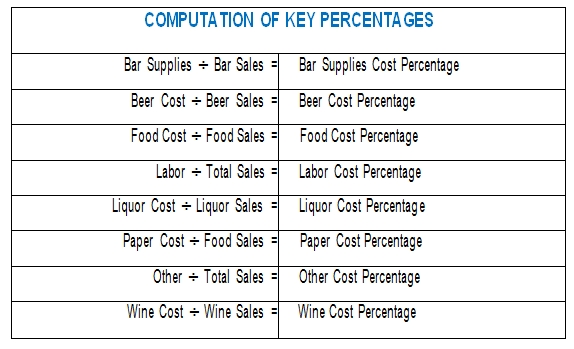 At the end of each month, it is important to close out all expenses and sales and balance all accounts. This process ensures that finances are being monitored and helps prevent financial problems down the line. It also lets you, the bar manager, see whether the bar is making a profit or not and what changes (if any) need to be made to operations.
At the end of each month, it is important to close out all expenses and sales and balance all accounts. This process ensures that finances are being monitored and helps prevent financial problems down the line. It also lets you, the bar manager, see whether the bar is making a profit or not and what changes (if any) need to be made to operations.
Closeout actually depends on what goes on financially in your bar all month. It is essential that all expenses are recorded each day. Not having a reliable list of expenses incurred is sure to result in inaccurate bookkeeping and many problems at audit time. You need to record all expenses—including those that are prepaid or those for which you get a bill.
Monthly Audit Procedures
On the last day of the month:
1. Gather the completed inventory forms for food, liquor, wine, and operational supplies.
2. Using current invoices and past inventories, cost out the Inventory Form. The unit cost (or price) entered on the Inventory Form must correspond to the item and unit in the actual inventory. Correct prices are ensured by continual evaluation of invoices and/or contact with the suppliers.
3. Ensure that the employees organize and clean the storage areas and walk-ins so that the ending inventory may easily be taken the following morning. Combine all containers and bottles. Organize and label all shelves.
4. Schedule the bookkeeper and the employees involved in taking the physical inventory—the assistant manager, kitchen director, bar manager, and general manager—to arrive early in the morning prior to the start of business on the first of the month.
5. Schedule the preparation cooks to arrive an hour after the inventory crew so that you may inventory the food areas without disturbing them.
On the following morning, the first of the month:
6. The bookkeeper should arrive as early as possible in order to complete all of his or her work prior to management's completion of the inventory:
A. Reconcile and record all the transactions from the previous day, as
usual.
B. Enter the information on the Daily Sales Report Form. Total,
double-check, and verify all the columns.
C. From the employee time cards complete, total, double-check, and verify the Labor Analysis Form.
D. Ensure that all purchases are recorded in the Purchase Ledger. Complete, total, double-check, and verify the Purchase Ledger for each company. Total the purchases in each expenditure category: food, liquor, wine, and each individual operational category.
Ensure that all paid-outs entered on the Cashier's and Bartender's Reports have been posted into the appropriate Purchase Ledger categories. Total the cash paid-outs. Add this figure into the purchase total for each expense category.

This article is an excerpt from the The Professional Bar & Beverage Managers Handbook: How to Open and Operate a Financially Successful Bar, Tavern and Nightclub, authored by Douglas Robert Brown, published by Atlantic Publishing Group. This excerpt has been reprinted with permission of the publisher. To purchase this book go to:


